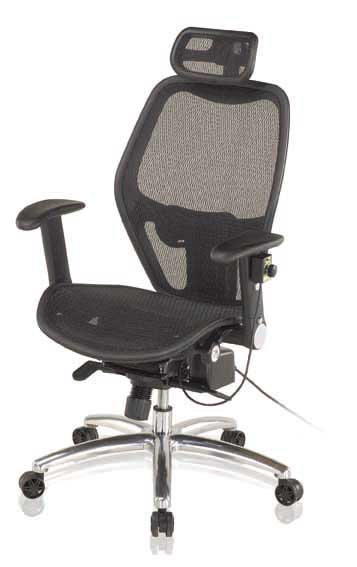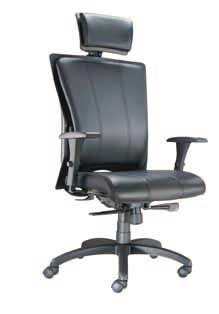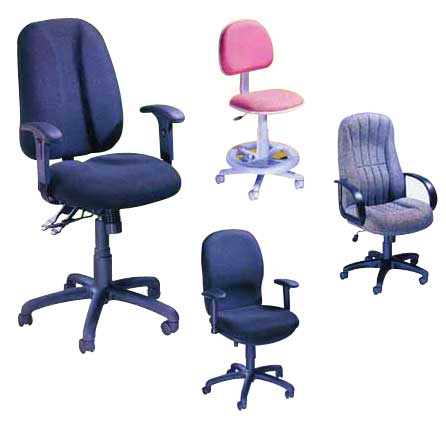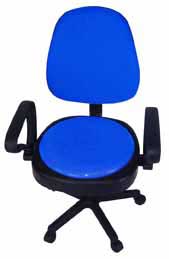OA Chair Makers Believe Local Conditions Still Favor Business in Taiwan
2008/02/22 | By Judy LiDespite the obvious downsizing of Taiwan's furniture industry in recent year due to the massive outflow of production lines to neighboring Southeast Asia and China, mainly caused by less favorable conditions at home-rising labor rates, land prices and clearly more competitive counterparts offshore-a significant number of manufacturers and suppliers of office furniture (often labeled as OA or office automation furnishings) have chosen to stay on the island, because they believe the manufacturing environment at home still works for the sector in many ways. In other words, there exists on the island a highly efficient, well-rounded network of subcontractors or satellite plants to turn out virtually all the needed parts, from high-end ABS file trays to low-elasticity polymeric mesh for highly popular, ventilated executive chairs, as well as making available wide ranging series of manufacturing technologies.


Today most OA furniture manufacturers in Taiwan focus on producing office chairs and related parts; while the sector has continually relied on delivering quality-assured products as its best weapon to carve out global niches. Equally noteworthy is the fact that some of these OA chair makers and suppliers have successfully achieved the coveted goal few have been able to do in Taiwan: win worldwide popularity with own-brand products.
Market observers say that the stable growth of the OA furniture sector in Taiwan is attributable to the well developed support industries, such as petrochemical, basic metals, hardware, machinery and electronics, all of which have helped directly or otherwise to enhance the gradual development and upgrading of Taiwan's OA furniture industry.
Cross-Industry Support
Realtors say that "location" is the key to success in their sector. The same principle applies to the OA furniture industry in Taiwan. Mostly located in central Taiwan, the manufacturers of machinery and hardware are conveniently near the OA chair makers. Such easy access to needed parts, machinery, technologies and potentially good ideas simply make OA chair makers' lives easier in acquiring cross-industry support. Such mutually-beneficial geographical layout, some believe, offers unparalleled advantage to the Taiwan sector that helps them outdo their counterparts in China. Viewed differently, bigger is not necessarily better in the OA furniture industry.

Having been involved in the production of OA chairs for more than two decades, Jia Goang Furniture Industry Co. has long built up its image in the international market with its quality, innovative products. "Jia Goang was established in 1987 in Nantou of central Taiwan, three years after I had been discharged from the draft," recalls Peter Lin, founder and general manager of the company.
"Before starting up the furniture business, I worked at a local metal parts factory and learned the manufacturing technologies of metal parts for various industries including furniture. With the know-how obtained from the factory, I decided to start up my own business by setting up a plant to make office chairs," Lin says. " I encountered a lot of difficulties in the beginning years, however, the difficulties did not undermine my will and perseverance to stay afloat in the line. Eventually I learnt the ropes and now have built a relatively solid foothold in the field."

Jia Goang is an integrated office chair manufacturer with the capabilities to produce raw materials, handle manufacturing processes, as well as final packaging. "To obtain advanced manufacturing technologies, we have cooperated with a Japanese plastic chemical manufacturer to fabricate high-end plastic materials that can enhance durability and safety of our chairs," Lin says.
In 1998 the company's manufacturing partner in China decided to suspend operations there and asked if Jia Goang intended to take over the plant. With comprehensive assessment on the manufacturing environment there, Jia Goang decided to take over the plant in 2000. Unfortunately the company suffered losses of around NT$20 million (about US$606,060 at US$1 = NT$33) in the China plant in the following two years after the purchase.
"In the first year of our operation, we spent considerable manpower and capital to streamline and restructure the works. But the second year saw the outbreak of the unexpectedly severe acute respiratory syndrome or SARS that forced the plant to virtually shut down all of the production lines," Lin says. "Nevertheless, we weathered the catastrophe and have seen rapid growth in revenues since the third year. The plant scored monthly revenue of 300,000 renmimbi (RMB) in the first several months of the third year and the corresponding revenue jumped to 800,000 RMB at the end of the year, both were much higher than the average monthly income of 80,000 RMB recorded by the plant prior to our takeover."
In 2005 Jia Goang's operations in China generated two million RMB in revenues per month and the figure in November of 2007 soared to more than five million RMB. "Today our plant in China has a workforce of about 150 persons and the one in Taiwan about 40 persons. The China plant sells 70%-80% of its products to local market and exports the remaining 20%-30% overseas; while the Taiwan plant sees the vice versa," Lin says.
Despite the tepid global economic climate, Jia Goang still witnessed annual rise of about 20% over the last several years, and the percentage for 2006 even skyrocketed by 150%. Currently the company ships office chairs worth more than NT$10 million (US$303,030) monthly from its plants on both sides of the Taiwan Strait and its export markets are mainly in Japan, the United States and Southeast Asia.
Massage Office Chair
Other than direct exports, the company also has sales agents in Japan and the U.S., not to mention those in both Taiwan and China. Recently the company has successfully developed a new model of office chair with integrated massage function. "My friend and I have been engaged in the manufacture of fitness equipment and jointly brainstormed the idea of building a chair that can enhance health, which is a particularly sound concept considering that office workers today often spend prolonged hours sitting. Eventually we came up with this massage chair, Lin says. In fact we even pushed the limit of conventional design, offering more than mere massage but also easy adjustment of the heights of armrests and seat."
This new chair is truly user-friendly as it offers adjustable heights in headrest, seat, lumber-support, as well as armrests. The back and seat of the new chair are made of breathable mesh, with a back that tilts backward in four stages. Most of all, there is a specially designed motor installed under the seat that automatically rotates the seat to massage the buttocks, hence stimulating circulation to ease fatigue from prolonged sitting. The chair is expected to be officially marketed soon.
Founded in 1992 in Tainan, southern Taiwan, Comfordy Co. is a professional manufacturer of home and office seating, providing a wide range of chairs with high quality and stylish designs. Although relatively young in the furniture industry, the company has already succeeded in building a sound image globally.
"We jumped into the seating industry right after our founding and have stayed focused product-wise, choosing not to diversify our line," notes Jerry Kang, sales manager of the company. "In the early years, we turned out chairs mainly on OEM basis, and have not until recent years started to develop self-designed products."
The company began to be pressured from competition from counterparts in China about seven or eight years ago, with such rivalry in recent years becoming increasingly serious and threatening, particularly in the last three years. To try to cope with and even outdo such competition, Comfordy has therefore paid more attention to R&D, forming a team of seven professionals to handle the development and marketing of new models of chairs.
"Initially our clients generally specified the designs so all we did was turn out products according to schematics and samples. In other words, we were merely a factory that produced what we were told to do. Times change, however, and the growing competition has forced us to be more innovative. After all, the underdog usually tries to catch up and that usually involves learning the basics and copycatting. But as the bottom-end segments are saturated with suppliers, buyers, who are looking to go upmarket with innovative products, may turn to source from mainland Chinese rivals," Kang says frankly.
To develop new models, the company has in recent years regularly sent its R&D technicians to international furniture shows both at home and abroad to collect industry information, hopefully at the same time be inspired by products displayed at the shows.
Deeply Plant the Root on the Island
Unlike most Taiwanese furniture makers, Comfordy has kept all of its operations in Taiwan and insisted to deeply plant the root on the island. Today the company runs two plants in southern Taiwan with a total staff of more than 60 persons. "We now generate 30% of our chairs on the OEM basis, 30% are manufactured as traditional models, and the remaining 40% feature value-added innovations with special designs," Kang says.
"To make sure our self-designed products are marketable, we usually exchange ideas with our clients on the drafts of the projected products before developing molds to mass produce them. The discussions allow us to continually improve product designs, a process that may be seen as one to work out all the bugs," Kang says.
In recent years Comfordy has unveiled each year at least two brand new chairs to meet the market need. To catch up with the world's environmental protection trend, the company is planning to apply non-toxic recyclable compound materials to the manufacture of its chairs. "We intend to cooperate with academic organizations or research institutions to jointly develop environmentally-friendly materials for our future products and hope to contribute efforts to the protection of the earth," Kang notes.
The company exports 95% of its products mainly to the United States, Europe, Australia, Japan, the Middle East, and Southeast Asia; and the remaining 5% are sold domestically. Russia and some emerging markets in Central Asia will be the company's future export targets. "Some of our clients once turned to China for cheap products, but now they all come back to purchase our 'quality' ones after having severe headaches with the problems caused by the defects of the cheap chairs," Kang points out sarcastically.
In addition to home and office chairs, Comfordy also turns out bar stools and special laboratory chairs. Despite all the hardships, the company has witnessed average annual rise of 20% in revenues in the last three years.
Established about four years in central Taiwan, Gin Uei Industry Co. is quite young in Taiwan's furniture industry. "Actually I have been manufacturing office chairs for more than 10 years and have not until four years ago jointly established the company with a close friend who used to be a furniture trader," says Jack Lai, general manager of Gin Uei.
Focusing on the development of high-end office chairs, Gin Uei boasts a sharp growth of 25% over the past year. "Quality is the company's motto. We have laid heavy emphasis on R & D and kept developing value-added innovative products that our counterparts in China and Southeast Asia can hardly copy in time," Lai remarks.
The United States is Gin Uei's major export outlet and its clients there also help the company with the development of new products. "Our products are 100% exported and the market in the U.S. absorbs 75% and that in Japan makes up of the remaining 25%. Our clients in the two countries often give us good ideas for the chairs we intend to create," Lai indicates.
Currently the company is actively involved in the development of health-oriented ergonomic chairs with the fabrics of the covers being made of special textiles that can resist static electricity. "The projected chairs are most suitable for workers at electronics firms where have more electronic articles in the air of the working areas," Lai explains. "Besides, the chemical formation of these high-end fabrics is quite complicated and not easy to be imitated." The company intends to unveil the chairs in March of 2008 and massively produce them immediately thereafter.
Unveiling New Models for 2008
In addition, Gin Uei plans to unveil four more new chair models for 2008 although the sharp price hike in raw materials has been quite a headache. "We have purchased most of the materials locally, including steel tubes, plastic parts, and fabrics. However, the prices of the said items are going up rapidly due to the soaring international oil and material prices," Lai complains. Nevertheless, the company believes that it will weather through all the difficulties to survive as long as it follows the principle of providing the best products and service to its clients.
Like Gin Uei, ASN Enterprise Co. is also located in central Taiwan and has joined the furniture industry for merely a couple years. "I have manufactured fitness equipment for more than two decades and about two years ago decided to expand the production lines to furniture items, mainly office chairs," Chen Wen-hsing, the company's general manager, states.
The company cooperates with several satellite plants to generate its products. "To diversify manufacturing risk, we have contracted some local plants to generate several kinds of parts, which are prestigious in their fields," Chen says. "Although entering the furniture industry only a couple years ago, I have felt that I can apply most manufacturing technologies in fitness equipment to office chairs."
Currently the company is aggressively promoting the newly developed OA chairs with smart, healthy, and balanced seat cushions. "The cushions of the chairs can be filled with either air or water to help cool the contact surfaces during summers. Besides, the ergonomically designed chairs effectively work to minimize fatigue due to extended sitting-specially designed to reduce the pressure on the spine inherent to sitting. Plus the chairs are easily assembled for DIY applications and markets," Chen says. The chairs are patented in both Taiwan and China and the company intends to apply similar patens in the U.S. soon.




